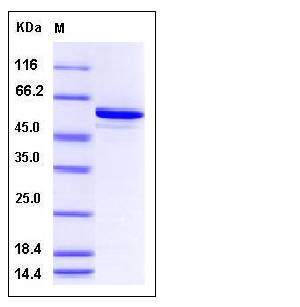Human BMPR1B / ALK-6 (149-502) Protein (His & GST Tag)
ALK-6,ALK6,CDw293
- 100ug (NPP1087) Please inquiry
| Catalog Number | P10460-H20B |
|---|---|
| Organism Species | Human |
| Host | Baculovirus-Insect Cells |
| Synonyms | ALK-6,ALK6,CDw293 |
| Molecular Weight | The recombinant human ALK6 (149-502)/GST chimera consists of 591 amino acids and has a calculated molecular mass of 68.3 KDa. It migrates as an approximately 55 KDa band in SDS-PAGE under reducing conditions. |
| predicted N | Met |
| SDS-PAGE |  |
| Purity | > 90 % as determined by SDS-PAGE |
| Protein Construction | A DNA sequence encoding the human ALK6 (NP_001194.1) cytoplasmic domain (Arg 149-Leu 502) was fused with the N-terminal polyhistidine-tagged GST tag at the N-terminus. |
| Bio-activity | Kinase activity untested |
| Research Area | Cancer |Invasion microenvironment |Angiogenesis |Cytokine & Receptor |Transforming Growth Factor Beta (TGF-beta) Superfamily |TGF-beta Superfamily Receptors | |
| Formulation | Supplied as sterile 50mM Tris, 100mM NaCl, pH 8.5, 20% gly, 0.3mM DTT 1. Normally 5 % - 8 % trehalose and mannitol are added as protectants before lyophilization. Specific concentrations are included in the hardcopy of COA. |
| Background | BMPR1B(bone morphogenetic protein receptor, type IB), also known as ALK6, is a a member of the bone morphogenetic protein (BMP) receptor family. BMPs are involved in endochondral bone formation and embryogenesis. These proteins transduce their signals through the formation of heteromeric complexes of 2 different types of serine (threonine) kinase receptors: type I receptors of about 50-55 kD and type II receptors of about 70-80 kD. Type II receptors bind ligands in the absence of type I receptors, but they require their respective type I receptors for signaling, whereas type I receptors require their respective type II receptors for ligand binding. BMPR1B is the major transducer of signals in precartilaginous condensations as demonstrated in experiments using constitutively active BMPR1B receptors. BMPR1B is a more effective trasducer of GDF5 than BMPR1A. Unlike BMPR1A null mice, which die at an early embryonic stage, BMPR1B null mice are viable. |
| Reference |
